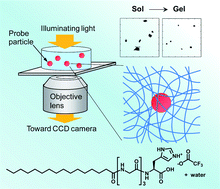Spatial heterogeneity in the sol–gel transition of a supramolecular system
Abstract
Heating and then cooling down a dispersion of a

* Corresponding authors
a
Department of Applied Chemistry, Kyushu University, Fukuoka 819-0395, Japan
E-mail:
k-tanaka@cstf.kyushu-u.ac.jp
Fax: +81-92-802-2880
Tel: +81-92-802-2878
b Department of Automotive Science, Kyushu University, Fukuoka 819-0395, Japan
c Nissan Chemical Industries, Ltd., Tokyo 101-0054, Japan
d Center for Future Chemistry, Kyushu University, Fukuoka 819-0395, Japan
e International Institute for Carbon-Neutral Energy Research (WPI-I2CNER), Kyushu University, Fukuoka 819-0395, Japan
Heating and then cooling down a dispersion of a

 Please wait while we load your content...
Something went wrong. Try again?
Please wait while we load your content...
Something went wrong. Try again?
D. P. Penaloza, A. Shundo, K. Matsumoto, M. Ohno, K. Miyaji, M. Goto and K. Tanaka, Soft Matter, 2013, 9, 5166 DOI: 10.1039/C3SM50225B
To request permission to reproduce material from this article, please go to the Copyright Clearance Center request page.
If you are an author contributing to an RSC publication, you do not need to request permission provided correct acknowledgement is given.
If you are the author of this article, you do not need to request permission to reproduce figures and diagrams provided correct acknowledgement is given. If you want to reproduce the whole article in a third-party publication (excluding your thesis/dissertation for which permission is not required) please go to the Copyright Clearance Center request page.
Read more about how to correctly acknowledge RSC content.
 Fetching data from CrossRef.
Fetching data from CrossRef.
This may take some time to load.
Loading related content
